Technology is at its best when it is invisible

Powerful technology can often be compared to a duck swimming in a pond. On the surface, it looks calm but below water, it’s paddling furiously. The technology that impacts our lives, most times can go completely unnoticed by us. We unconsciously pull out our phones to Google a question or connect our phones to our car’s BlueTooth to take a call while we drive, without thinking much about it. If we were to lose internet connectivity, that is when it hits us how dependant we are on technology.
The common thread in all these technologies is that they are so simple to use, we don’t even think about using them - they’ve assimilated into the fabric of our everyday lives.
This is the goal insurance providers in the U.S. should try to achieve with their software. The best insurance software is one that is so simple to use, that your agents and customers don’t even notice it’s there. While in the background, this invisible technology is enabling countless operations that help your company run smoothly.
How visible is your insurance software?
When technology is working as it should, no one even notices it’s there. But when it’s ineffective, your operations can come to a complete standstill. The visibility of software can be observed in three broad areas:
-
Productivity of agents: Complex insurance software requires your agents to switch between different platforms and complete multiple steps to get the information they need. This complexity can lower employee adoption rates and impact the efficacy of the tool. As a result, your agents could be spending a disproportionate amount of time on manual tasks and less on the strategic work they’re hired for.
-
Onboarding of new agents: A good barometer of the simplicity of your insurance software is the amount of time it takes for a new agent to learn how to use it. If your agents require a very long training period before they are able to effectively use the platform, then that’s a failure of the software, not your agents. Insurance software should be almost intuitive to use. The dashboard should be easy to understand and your agents should be able to gain mastery over it relatively quickly.
-
Quality of customer experience: Arguably, one of the biggest business impacts ineffective ‘visible’ software has is on the quality of customer experience. Ease of signing up, short wait times and limited manual paperwork are some of the most important determinants of positive customer experience in insurance. Ineffectual admin systems can result in the exact opposite. The lack of proper information architecture can mean that your agents are asking customers questions that they should already know the answer to. Policy decisions or renewals are delayed because of siloed data structures. In a competitive industry that is seeing new players emerge, poor customer experience can be the difference between acquiring and losing customers.
Visible, hence ineffective software, isn’t just an admin issue. The loss in productivity and new business opportunities can result in net dollar losses for your company as a whole.
More of Interest: Why Technology Helps You Compete with Insurance Giants
Markers of invisible technology
Invisible technology solutions have the bulk of the work happening in the backend and require minimal intervention by agents or customers. Some of the signs of invisible technology include:
1. Automated workflows for manual tasks
Automation in insurance for carriers in the U.S. is undeniably the biggest game-changer in creating invisible, efficient processes. There are countless applications of automation-first technology, right from data entry to customer support. But regardless of the application, the final outcome of properly automated processes is lesser human dependency and quicker completion of tasks.
SimpleSolve’s automation-first Policy Management software uses AI and ML to automate the issuance of new business policies, renewals, and cancellations. This takes a significant load off your agents, helping them to focus on more value-driven aspects of their work. Customers also benefit from automation in insurance because it requires less time for their requests to be processed and the results are far more accurate.
2. Cloud-based software systems
One of the most obvious and literal signs of visible admin systems is an on-premise legacy system. On-premise systems are especially inefficient today when employees are working remotely and need infrastructure that enables them to do so. Cloud-based platforms offer greater flexibility and agility. As an added bonus, working out of the cloud can actually prove to be more cost-effective for your company.
Bulky infrastructure requires constant IT maintenance and complicated disaster recovery in the event of a cyber attack. The cloud, on the other hand, is simple to operate out of, can be accessed from any location, offers sophisticated cybersecurity measures and is easier to maintain. SimpleINSPIRE has state-of-the-art cloud-based technology for optimal performance and load balancing. It works silently in the background to ensure that your agents can work uninterrupted.
Read also: Can Automated Underwriting Impact Quality of Your Customer Base?
3. Integrated data repositories
Data silos can be one of the biggest threats to efficiency and customer satisfaction. Customer information entered by one department might not get passed on to another. This can result in your agents asking customers for the same information multiple times. Complex information architecture also creates a roadblock in your internal operations because departments are not working out of a common database and knowledge isn’t being shared effectively.
Invisible IT systems work with users, agents, and IT departments to ensure that information flows seamlessly. SimpleINSPIRE, for example, has a unique context-based navigation that integrates all functions and automatically provides agents with all incidental information to complete a transaction from a common repository.
4. User-friendly platform
Visible admin systems often have a very high technical threshold. This means that the onus to keep systems updated rests on the IT departments and agents can find it difficult to maneuver through the platform.
Invisible technology is designed with a user-first approach. It is extremely simple to use and the information architecture requires less dependence on IT teams.
SimpleINPIRE for instance, allows agents to update customer profiles themselves. The new information doesn’t have to adhere to pre-defined templates and can include unconventional information such as images, call notes, audio recordings, etc. This empowers users to maintain the technical environment themselves if they need to, perform backups and troubleshoot issues. However, most insurance carriers prefer to get their technology partners to maintain the systems.
Customers are also able to access the IT environment through features like self-service portals that help them get information faster and deflect queries from agents.
Invisible technology might be inconspicuous, but its effects are very much apparent. Smarter insurance software can result in happier customers, productive agents, and an organizational structure that can easily respond to the changing demands of the market.
Is it time your tech went invisible?
Topics: Legacy System Modernization







